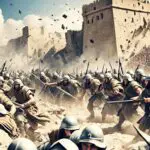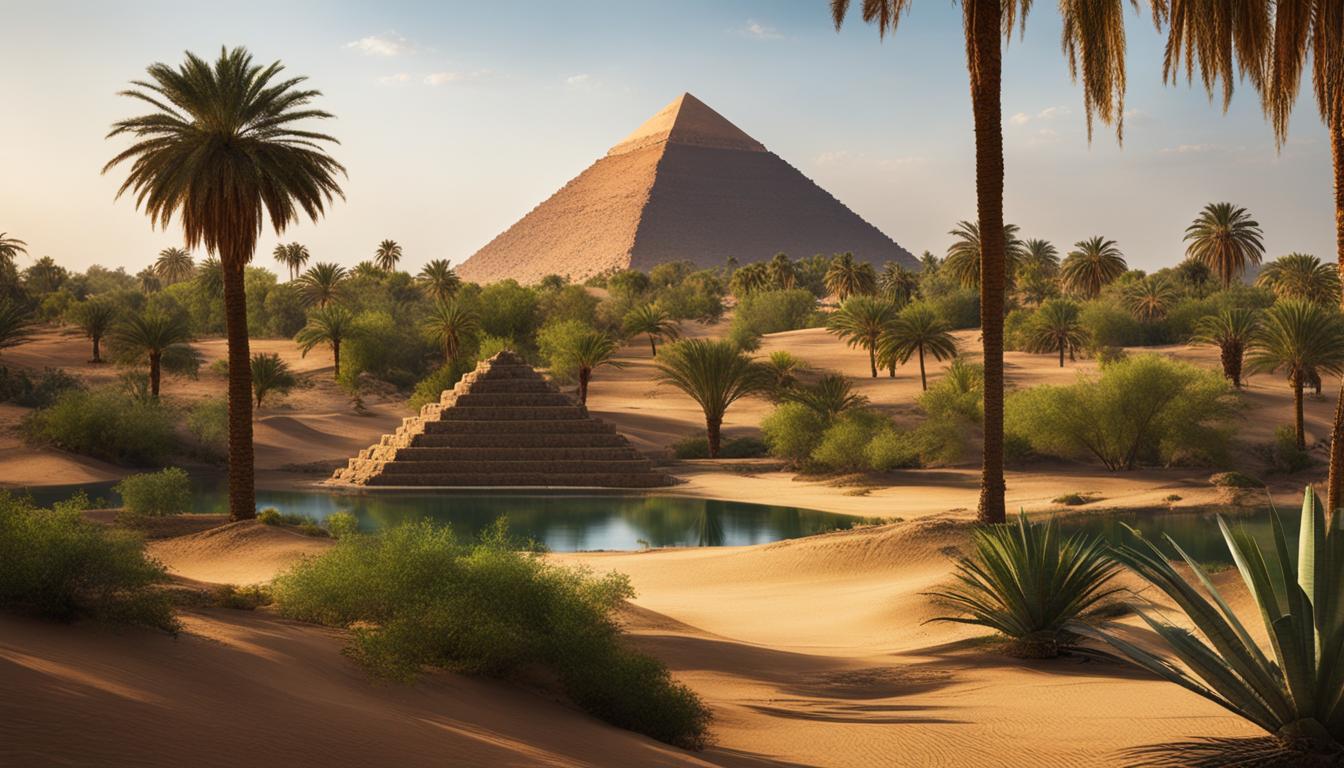Welcome to the ancient tale of Goliath and the legendary warrior who stood against him in the Valley of Elah. This biblical figure has captivated audiences for centuries, and the valley itself holds a significant place in history. Let’s delve into this epic battle and explore the profound impact it had on the Israelites and the Philistines.
Key Takeaways:
- Goliath and the Valley of Elah are part of a well-known biblical tale.
- The valley is linked to a pivotal battle between the Israelites and the Philistines.
- David, a young and inexperienced warrior, faced off against Goliath, a formidable giant.
- The battle marked an important turning point in the conflict between the two nations.
- The Valley of Elah holds historical and cultural significance for visitors today.
The Historical Background of the Valley of Elah
In ancient history, the Valley of Elah served as a battleground between the Philistines and the Israelites. The Philistines, a powerful and technologically advanced Canaanite people, inhabited the region before the arrival of the Israelites. They worshiped false gods such as Baal and Dagon and possessed advanced iron technology. The Valley of Elah held strategic significance for the Philistines as they aimed to penetrate the heart of Judah.
During King Saul’s reign, a pivotal battle took place in the Valley of Elah between the Philistines and the Israelites. The outcome of this battle would determine which nation would serve the other. It was a “winner takes all” confrontation, with high stakes for both sides. However, the arrival of a young shepherd boy named David would ultimately change the course of history.
“The Philistines, a formidable force equipped with advanced weapons, clashed with the Israelites in the Valley of Elah. This battle would test the prowess of both nations and shape the destiny of ancient Israel.”
David, anointed by the prophet Samuel, stepped forward to face the towering Philistine warrior Goliath. Armed with only a sling and a stone, David took on the challenge without wearing any conventional armor. Against all odds, he defeated Goliath, striking him in the forehead and ending the threat posed by the Philistines. This extraordinary victory solidified David’s status as a heroic figure and marked the beginning of his rise to power.
The Battle of David and Goliath
The iconic battle between David and Goliath in the Valley of Elah exemplified the Israelites’ faith in God and the courage of individuals in the face of adversity. David’s triumph over Goliath became a timeless tale of bravery, inspiring people throughout the ages.
The Technological Divide
The Philistines’ advanced iron technology showcased the stark contrast between the two nations. While the Israelites were still transitioning from bronze weapons, the Philistines possessed the technological superiority that gave them an edge in battle.
The Worship of False Gods
The Philistines’ devotion to false gods was deeply entrenched in their culture and spirituality. Their worship of idols like Baal and Dagon stood in stark contrast to the monotheistic beliefs of the Israelites, who worshipped the one true God.
| Philistines | Israelites |
|---|---|
| Advanced iron technology | Transitioning from bronze weapons |
| Worshiped false gods | Devoted to the one true God |
David’s victory over Goliath not only vanquished a powerful adversary but also symbolized the triumph of faith and divine intervention over physical might and false gods. The historical background of the Valley of Elah serves as a testament to the enduring power of courage, faith, and the ability of one individual to change the course of history.
Places of Interest in the Valley of Elah
The Valley of Elah is a treasure trove of historical and archaeological sites. From the Israelite camp to the Philistine camp, there are numerous places that hold great significance. The valley itself served as the battleground for the legendary encounter between David and Goliath, a battle that has captivated people for centuries.
The Israelite Camp
The Israelite camp, where King Saul and his army were stationed, was a central location during the conflict with the Philistines. This camp was the base for Saul’s forces as they prepared to face the mighty Philistine warriors. The camp represents the resilience and determination of the Israelites in the face of a daunting enemy.
The Philistine Camp
The Philistine camp, located at Ephes-dammin, was the stronghold of Goliath and his fellow warriors. It was from this camp that Goliath issued his challenge to the Israelites, instilling fear and uncertainty among them. The Philistine camp symbolizes the power and dominance of the enemy that David bravely faced.
Battle Location
The exact location of the battle between David and Goliath in the Valley of Elah has long been a topic of debate among scholars. While the precise spot may not be known with certainty, the battle took place in this valley, forever making it a site of historical significance.
King David’s Palace Fortress
Following his victory over Goliath, King David is believed to have built a palace fortress in the Valley of Elah. This fortress, with its remnants of walls and buildings, provides a glimpse into the architectural and military prowess of King David’s time. Notably, a replica of a temple associated with David was discovered, adding to the allure of this ancient site.

The places of interest in the Valley of Elah offer visitors a chance to step back in time and immerse themselves in biblical history. The Israelite and Philistine camps remind us of the monumental battle that took place here, while the battle location itself carries the weight of ancient conflicts. King David’s palace fortress stands as a testament to the enduring legacy of David’s bravery and leadership.
| Places | Description |
|---|---|
| The Israelite Camp | The base camp for King Saul and his army. |
| The Philistine Camp | The stronghold of Goliath and his fellow warriors. |
| Battle Location | The site where David and Goliath clashed. |
| King David’s Palace Fortress | Believed to be the fortress built by King David after his victory. |
The Valley of Elah in the Bible
The battle in the Valley of Elah is vividly depicted in the Bible, offering a detailed account of the events that transpired. The setting is described as a [battle setting](#), with the Philistines and Israelites positioned on opposite sides of the valley, ready for confrontation.
Goliath, a fearsome warrior equipped with daunting armor and weaponry, emerged from the Philistine camp, issuing a challenge to the Israelites. He demanded that they send forth a champion to face him in single combat to determine the outcome of the battle. The Israelites, gripped by [Israelite’s fear](#), remained paralyzed and unable to respond.
It was at this critical juncture that David, a young shepherd, arrived at the Israelite camp. Upon learning of the situation, he mustered the courage to confront Goliath and accept his challenge, defying conventional [battle terms](#). David, known for his unwavering faith in God, embarked on this perilous mission without wearing any armor.
“You come to me with a sword, a spear, and a javelin, but I come to you in the name of the Lord of hosts, the God of the armies of Israel, whom you have taunted.”
With a simple sling and a stone, David hurled the projectile with precision, striking Goliath in the forehead. This momentous blow caused Goliath to collapse, ultimately leading to his demise. The [outcome of the battle](#) defied all expectations, as David emerged as the victor against the mighty warrior.
This awe-inspiring triumph marked a pivotal moment for David, solidifying his reputation and setting him on the path to becoming the legendary King of Israel. The tale of David’s valor and triumph over Goliath in the Valley of Elah serves as a testament to the power of courage, faith, and the indomitable human spirit.

Key Points:
- The battle took place in the Valley of Elah.
- Goliath, a Philistine warrior, challenged the Israelites to send forth a champion.
- David, a young shepherd, volunteered to face Goliath without wearing any armor.
- With a sling and a stone, David defeated Goliath and marked the beginning of his rise to power.
The Valley of Elah as an Archaeological Site
Archaeological excavations in the Valley of Elah have yielded significant discoveries, shedding light on the region’s ancient history. One of the most notable finds is the fortified city of Khirbet Qeiyafa, dating back to the Iron Age II. This archaeological site is believed to have existed during the time of King David and provides intriguing insights into the United Monarchy described in biblical accounts.
The fortified walls of Khirbet Qeiyafa support the notion that it could have been a major stronghold during that period. The architecture and defensive structures of the city illustrate the military advancements of the time and offer a glimpse into the strategic importance of the Valley of Elah.
However, there is ongoing scholarly debate regarding the interpretation of the findings at Khirbet Qeiyafa. Some experts suggest that it could represent either a Judahite or Canaanite fortress, challenging the traditional understanding of its historical significance. This ongoing discourse adds to the richness and complexity of the archaeological evidence in the Valley of Elah.
In the words of renowned archaeologist Dr. Karen Polinger Foster:
The discovery of Khirbet Qeiyafa has presented us with an exciting puzzle. The fortified city’s location and grandeur raise questions about the political structures and power dynamics during the Iron Age. It invites us to rethink our understanding of the United Monarchy and its influence in the region.
Archaeological Finds in the Valley of Elah
| Artifact | Significance |
|---|---|
| Stone inscriptions | Provide valuable insights into ancient Hebrew script and language |
| Pottery fragments | Offer clues about the daily life and material culture of the inhabitants |
| Weapons and tools | Illuminate the military technology and craftsmanship of the time |
| Jewelry and ornaments | Reveal details about personal adornment and societal norms |
These archaeological finds contribute to a deeper understanding of the ancient societies that inhabited the Valley of Elah during the Iron Age. They provide valuable glimpses into the material culture, social dynamics, and technological advancements of that era.
The Importance of the Valley of Elah
The Valley of Elah serves as a gateway to uncovering the complexities of biblical narratives and the historical context in which they unfolded. Through archaeological exploration, scholars and researchers have the opportunity to piece together the puzzle of ancient civilizations and shed light on the stories, events, and figures described in religious texts.
By examining the archaeological evidence in the Valley of Elah, we gain a deeper appreciation for the rich tapestry of human history and the interconnectedness of ancient cultures. These discoveries not only provide valuable insights into the past but also have the potential to challenge and reshape our understanding of biblical accounts.

The Importance of the Elah Valley in Biblical Narrative
The Elah Valley holds significant biblical significance in the historical context of the ancient Israelites and Philistines. Situated at a strategic location between the coastal cities and the land of Judah, the valley became the battleground for control over the fertile land.
It was in this valley that the legendary confrontation between David and Goliath took place, marking a pivotal moment in history. David’s victory over the formidable giant Goliath became the catalyst for his rise to power.
“The battle showcased David’s courage, faith in God, and his ability to overcome seemingly insurmountable odds.”
The historical context of the battle provides insights into the ongoing conflict between the Israelites and the Philistines. It underscores the perseverance and strength of the biblical figures involved, highlighting their unwavering dedication to their respective causes.
| Biblical Significance | Strategic Location | David’s Rise to Power | Historical Context |
|---|---|---|---|
| Highlights the pivotal battle between David and Goliath | Located at a strategic crossroad in ancient times | Marked the beginning of David’s journey to becoming king | Sheds light on the ongoing conflict between the Israelites and the Philistines |
Exploring the Valley of Elah Today
Today, the Valley of Elah is a popular tourist attraction, attracting visitors from around the world who are intrigued by its historical and biblical significance. While there are no direct archaeological finds specifically tied to the legendary battle between David and Goliath, exploring the valley and walking through its hallowed grounds is a rewarding experience in itself.
The Valley of Elah offers not only historical significance but also breathtaking natural beauty. With its picturesque views and opportunities for hiking, it is a haven for nature lovers and outdoor enthusiasts. Visitors can immerse themselves in the tranquil surroundings while contemplating the events that unfolded in this ancient place.
To make the most of their visit, tourists can take advantage of guided archaeological tours that provide deeper insights into the history, archaeology, and significance of the Valley of Elah. These tours offer expert commentary and allow visitors to engage with the stories and legends that have made this valley an enduring symbol of courage and triumph.

“Exploring the Valley of Elah was like stepping back in time. The sheer historical significance of this place is awe-inspiring. Walking through the valley and imagining the legendary battle that took place here is an experience I will never forget.”
The Significance of the Valley of Elah
- Symbolic location of the legendary battle between David and Goliath
- Historical importance in ancient Israelite and Philistine conflicts
- Presence of remarkable archaeological sites
- Natural beauty and stunning landscapes
| Historical Significance | Natural Beauty |
|---|---|
| The Valley of Elah played a significant role in the ancient conflicts between the Israelites and the Philistines, making it an important site for understanding the region’s history. | The valley boasts beautiful landscapes, including rolling hills, fields of wildflowers, and stunning sunsets, making it a haven for nature lovers. |
| The battle between David and Goliath marked a turning point in Israelite history, portraying the triumph of courage and faith against overwhelming odds. | Visitors can enjoy hiking trails that offer panoramic views of the valley, providing ample opportunities for photography and relaxation in a serene environment. |
The Flora and Fauna of the Elah Valley
The Elah Valley is a treasure trove of biodiversity, boasting a diverse range of indigenous trees, plant species, and animal species. The valley derives its name from the abundance of terebinth trees that grace its landscape, creating a lush and picturesque environment.
Among the native plant species in the Elah Valley, you will find majestic oaks, nutritious carob trees, aromatic sage, and a vibrant array of wildflowers. These plants play a crucial role in maintaining the ecological balance and preserving the natural beauty of the valley.
“The Elah Valley is a haven for nature enthusiasts, offering a glimpse into the astounding variety of plant life that thrives in this region. From the towering terebinth trees to the delicate wildflowers, every step through the valley is an opportunity to immerse oneself in the wonder of nature.” – Nature enthusiast
As you explore the Elah Valley, you may encounter a fascinating assortment of animal species that call this diverse ecosystem home. Gazelles gracefully traverse the meadows, jackals stealthily navigate the underbrush, and foxes dart through the woodland. Slow-moving tortoises can also be spotted, adding a touch of serenity to the vibrant tapestry of life that flourishes here. The coexistence of these animal species showcases the harmony and interconnectedness of nature in the Elah Valley.
The rich biodiversity observed in the Elah Valley contributes to its ecological significance and underscores the importance of preserving and protecting this natural treasure for future generations.

Plant and Animal Species in the Elah Valley
| Indigenous Trees | Plant Species | Animal Species |
|---|---|---|
| Terebinth trees | Oak, Carob, Sage, Wildflowers | Gazelles, Jackals, Foxes, Tortoises |
Cultural and Environmental Preservation in the Elah Valley
Due to its historical and environmental importance, efforts have been made to preserve and protect the Elah Valley. In recent years, the region has come under threat from shale oil extraction projects, which raised concerns about the potential environmental impact.
Conservation organizations and grassroots groups have been actively involved in blocking these projects and raising awareness about the importance of preserving the valley’s cultural and natural heritage. Their conservation efforts aim to ensure the long-term protection of the Elah Valley.
In 2019, the Elah Valley was officially designated as a national park by the Israel Nature and Parks Authority. This designation reflects the significance of the valley and underscores the commitment to its preservation and environmental protection.
| Conservation Efforts | Environmental Protection | Historical Preservation | National Park |
|---|---|---|---|
| Conservation organizations and grassroots groups actively working to preserve the Elah Valley. | Raising awareness about the potential environmental impact of shale oil extraction. | Efforts to protect the valley’s cultural heritage and historical significance. | The Elah Valley designated as a national park in 2019. |
This national park status ensures that the Elah Valley will be safeguarded for future generations, allowing them to appreciate and learn from its rich cultural and environmental legacy.
Conclusion
The Valley of Elah holds great historical significance as the setting of the legendary battle between David and Goliath. This biblical battle continues to captivate the imagination, showcasing the triumph of a young and determined David against the formidable Goliath. Visitors today are drawn to the valley, eager to explore its historical roots and admire its natural beauty.
Alongside its biblical importance, the Valley of Elah boasts breathtaking natural landscapes that contribute to its allure. The indigenous trees, such as terebinth, oak, and carob, create a picturesque backdrop, while diverse animal species like gazelles and foxes add to the Valley’s ecological richness.
Recognizing the value of the Valley of Elah, conservation and preservation efforts have been implemented. These efforts aim to protect both the cultural and environmental heritage of the valley, ensuring that future generations can enjoy its splendor. The recent designation of the Elah Valley as a national park is a testament to these ongoing preservation initiatives.
As a unique combination of biblical history, natural beauty, and preservation efforts, the Valley of Elah remains a destination of importance and fascination. Visitors can immerse themselves in the epic tale of David and Goliath while exploring the stunning landscapes that have been preserved for generations to come.







